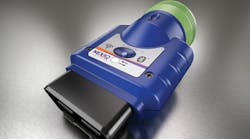When adding truck-mounted equipment to vocational (work) trucks, it is essential to make the time for up-front considerations about needs, capabilities and options. The objective is to get equipment that meet's a truck's specific work requirements for its intended application.
Not doing so will end up costing more in the long run due to a loss of productivity. It could also affect the safety and convenience of the truck operators.
CRANES
There are three important factors to consider in order to correctly specify a truck-mounted crane, say officials at truck crane manufacturer Liftmoore (www.liftmoore.com). They are:
- How much weight will be lifted, including all rigging used.
- How far out from the center of rotation will the load be?
- How often will the lift be made?
The maximum capacity of a crane is, as you would expect, the crane's maximum lift capacity. However, Liftmoore officials do not recommend purchasing a crane for use at its maximum lifting weight.
While two cranes may be listed as 6,000-lb capacity cranes, their capacities may actually differ within the working load zones of the crane. Calculating the load moment capacity required, then comparing it to the load moment rating of the prospective crane, can eliminate problems down the road.
A crane's maximum load rating is determined by the crane's load moment or moment rating. This is the weight of the load being lifted multiplied by the distance between the load's center of gravity and the center line of the crane.
The shorter the distance, the lower the load moment. That is why heavier lifts should always be done as close as possible to the crane.
TYPES OF CRANES
There are basically three types of truck-mounted cranes: electric, hydraulic and articulating, also known as the "knuckleboom."
Electric cranes, which don't require the engine to be running to power the crane, offer a low cost of entry, according to officials at Iowa Mold Tooling (IMT), a company that designs and manufactures mechanic's trucks, lube trucks, tire trucks, air compressors and truck-mounted cranes (www.imt.com). Electric cranes are suitable for those applications where lifting needs are fairly light and duty cycle operations are intermittent.
They are not intended for extended continuous operation periods as constant use throughout an operation will dramatically reduce battery life and add pressure to the electrical system, officials at Auto Crane, a manufacturer of electric and hydraulic cranes, crane service bodies and accessories (www.autocrane.com), add.
Heat buildup can also become a hurdle during an electric crane's operation, note officials at Service Trucks International, a builder of crane, service and lube truck bodies (www.servicetrucks.com). Electric cranes are limited to the duty cycle (heat generated) of the electric motors that power them. They work well if there is enough time between operations for the motor to cool to ambient temperature.
What's more, the power of the electric motor typically limits the size of an electric crane to a 6,000- to 6,500-lb maximum lift capacity, they say.
Applications that require extended crane operation periods, shorter cycle times and higher lifting capacities are best served by using a hydraulic-powered crane, say Service Trucks International officials.
HYDRAULIC CRANES
Hydraulic cranes require a power take-off and pump configuration to produce the necessary fluid-filled hydraulic system flow to power the crane, Auto Crane officials explain. This requires the engine to be running, often at higher than idle rpms, during operation.
Hydraulic cranes also offer greater control (proportionality) of the crane and faster operation, and hold up to higher cycle counts better than electric cranes, they add.
Hydraulic telescopic cranes have a wide enough range of lift and reach capabilities to meet most field service needs.
The cranes, however, have a lift capacity limitation because of the service bodies they are mounted on, IMT officials say. The size of a crane and the size of the truck go hand-in-hand.
ARTICULATING CRANES
If the lifting requirements exceed the capabilities of a hydraulic crane, or jobsite conditions limit access to the work area, an articulating crane can be an effective alternative.
These types of cranes are suited for those applications that need more lift and reach, IMT officials say. These cranes can operate lower to the ground so they are helpful in avoiding overhead obstructions. Because they are also typically lighter than hydraulic telescopic cranes of comparable capacity, they can carry more payload.
Articulating cranes, which come with stabilizers built into the crane base, also enable more precise placement of material.
AIR COMPRESSORS
With truck-mounted air compressors, the key is to correctly size a compressor to the application. If a compressor is undersized, it will take more time to finish a task. If oversized, there may be efficiency issues.
A compressor is usually sized according to the amount of air it can compress to 100 lbs per square inch (psi) in one minute, which is denoted in cubic feet per minute (cfm), officials at Kaeser Compressors, a leading worldwide manufacturer of energy-efficient compressed air equipment (www.kaeser.com), say.
Altitude can affect cfm ratings, note officials at Chicago Pneumatic, a quality leader in performance air tools since 1901 (www.cp.com). The higher the altitude, the thinner the air and the less cfm a compressor can generate. Air compressor manufacturers have charts available that will outline cfm ratings at higher altitudes.
The first step in determining the size of air compressor needed is to determine the types of tools that will be running. Then, the cfm requirements to run the tools need to be established. This information is typically labeled on the tool, or can be found in the owner's manual.
Next, determine if there will be the need to run more than one tool simultaneously, and how often air will be needed. Some compressors have several outlets to power multiple tools.
Undersizing an air compressor is usually not the problem, note officials at Vanair, the world's largest manufacturer of powerful, lightweight and compact vehicle-mounted air compressors, generators, welders and battery boosters (www.vanair.com). A common mistake is the tendency to oversize the unit.
Most pneumatic tools are rated at 90 to 110 psi, they point out. Delivering higher pressures to the tools than required can cause damage and will shorten tool life.
Oversizing can also impact the compressor's longevity, add officials at Doosan Infracore Portable Power, whose product line includes generators, air compressors and light towers (www.doosanportablepower.com/americas). A compressor that is too large won't work hard enough. If it is never really loaded, it won't build up enough heat to evaporate the moisture, and that can shorten the life cycle.
The inability to achieve the desired operating cycle can also lead to trouble with the air/oil separation system that removes the compressor oil (used to lubricate the system) from the compressed air, they add.
Air compressors come in rotary screw and reciprocating piston models and each has certain benefits.
Rotary screw compressors are compact, lighter in weight than reciprocating piston compressors and are designed to run for extended periods of time, making them more efficient, say IMT officials. Plus, they have on-demand air. As soon as the compressor comes on, it is producing air.
Reciprocating compressors are designed for short, intermittent job needs, they continue. These models are more forgiving, are not as susceptible to moisture or particulate contamination and are "significantly" less expensive than rotary screw units.
MULTIPURPOSE UNITS
Weight and space are precious commodities on almost any vocational truck. For work trucks that need a welder, generator and compressor on a regular basis, the functionality of a multipurpose unit can offer a number of advantages
Combining the compressor, welder and generator into one unit reduces vehicle weight, helping to lower fuel costs and decrease wear and tear on the truck, and provides savings on service costs. Additionally, it opens up more space on the truck for hauling tools and materials.
Keep in mind that if one component in a compressor/welder/generator unit fails, the other two components are also unusable, point out IMT officials. Consequently, it is important to adhere to recommended preventative maintenance schedules.
Servicing is simplified because by having the compressor, welder and generator in one self-contained unit there is only one service point for all three components.




